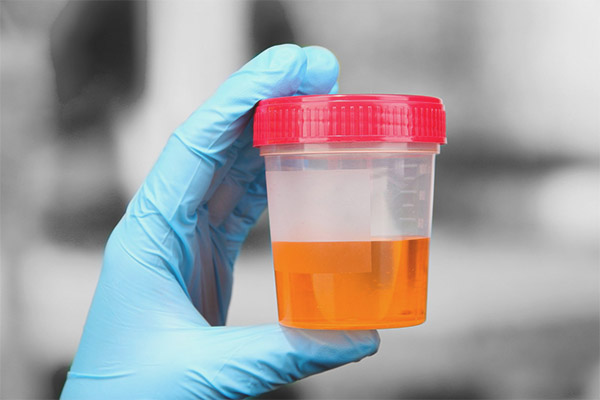The content of the article
Normal urine in dogs is a straw yellow color with no pronounced odor. If the color of the discharge changes, then it may indicate that there is a pathology in the body. The dark mustard color of urine indicates dehydration, and orange indicates diseases of the liver or gallbladder. Too dark urine, a brown and almost black shade may indicate the presence of a malignant tumor. Discharge with the presence of blood, in turn, is a symptom of various disorders that may be dangerous.
The reasons
Often, the presence of blood in the urine occurs with sufficiently serious pathologies. The reasons for this phenomenon may be as follows:
- Food or medicine that stains urine. If an animal eats vegetables that have a rich color, then the excretion of vital activity may acquire an appropriate shade.In this case, if the change in color of the urine is not accompanied by other symptoms, then the alarm should not be beaten.
- Traumatic injuries in the pelvic region. In case of a fall from a long distance or an accident caused by a dog getting under the wheels of a car, serious damage to the internal organs can occur, which are accompanied by blood ingestion in the urine.
- Diseases of the reproductive system in females. In such situations, the animal urine can have blood impurities. As a rule, in such situations this phenomenon is accompanied by a weak appetite, an increase in the volume of the abdomen. Treatment often involves resection of the reproductive organs.
- Prostate diseases in males. They are accompanied by additional symptoms in the form of problems with defecation, bouts of vomiting, problems with urination. Such pathologies require medical care, medical treatment or surgery.
- The presence of stones in the kidneys and other organs of the urinary system. They arise from pathologies of the cardiovascular system and the liver. In this case, urination is accompanied by pain and discomfort,what you can draw conclusions on the behavior of the dog. As a rule, urolithiasis is accompanied by cystitis, pyelonephritis, renal failure. Such pathologies require treatment in the form of physiotherapy, bladder washing, and the use of painkillers. In some cases, diuretics, anti-inflammatory drugs and antibiotics are indicated. First of all, using diagnostics, it is required to determine what is the cause of urolithiasis.
- The presence of parasites in the body. Worms that feed on the blood of dogs can cause blood to appear in the urine. Their presence leads to the destruction of red blood cells, resulting in urine becomes reddish. Besides her, the dog's faeces are also stained. The animal can lose weight dramatically, has restless sleep, suffers from a disorder in the stool or constipation. The problem is solved by taking antihelmintics in a specific pattern. To strengthen the immune system, vitamin complexes are prescribed, symptomatic treatment is carried out. Blood-sucking parasites, such as fleas or ticks, can also cause blood to appear in the urine.
- Willebrand disease.Is a genetic pathology that provokes the excretion of blood in dogs from different parts of the body.
- Due to surgery. For example, after castration or sterilization, blood may have impurities for some time.
- Infectious diseases of the urinary system. Such symptoms are usually accompanied by cystitis, urethritis, pyelonephritis. In addition to bloody inclusions in the discharge, such diseases are accompanied by pain when urinating, swelling in the genital area, apathy, lack of appetite. In such cases, after going to the toilet a drop of blood is released, which is the cause of urine staining. In this situation, the pathology is accompanied by additional symptoms. An accurate diagnosis can only be established by a specialist after appropriate examination. As treatment, antibacterial and symptomatic therapy is prescribed.
- Toxic effects of toxic substances. Poisoning can be caused by poisons, such as rat, which cause the destruction of red blood cells. If such a poison enters the dog's body, it leads to vomiting, convulsions, pain, and blood clots in the urine.Other toxic substances can also be the cause of poisoning, for example, some types of fungi, snake bites and insects. In this case, the dog requires immediate medical attention.
What to do?
The presence of blood in the urine is most often a consequence of the presence of serious pathological conditions that require treatment. If this happened only once, then it is necessary for some time to carefully observe the dog, to remember if the pet did not eat beets or other brightly colored vegetables that could cause a change in the color of the urine.
If the abnormal hue of the discharge is accompanied by additional symptoms:
- Drowsiness and apathy, lack of mood and a decrease in normal activity.
- Nausea, dizziness and vomiting.
- A change in behavior, for example, a dog tries to hide in a secluded place or shows unusual aggression towards others.
- The requirement of increased attention to the owner, etc.
It is urgently necessary to consult a veterinarian for an accurate diagnosis and adequate treatment.After all, timely correction of the condition and correctly taken measures are a guarantee of recovery.
Diagnostics
The doctor collects anamnesis, analysis of complaints, internal examination and study of symptoms. For the diagnosis, blood and urine tests of the animal, X-ray and ultrasound examination are prescribed.
The owner of the dog must pay attention to:
- The general condition of the dog: the presence of elevated body temperature, the amount of food consumed, the consistency of feces.
- From which part of the body blood is released. It is important to determine if the feces have blood impregnations or it is only in the urine. In diseases of the reproductive system, droplets of blood are secreted from the genitals. To understand what caused the staining of urine, you need to look at the dog's tail, for sure the bleeding will be from the organ where there is a pathological process.
- Does the animal have pain when urinating? Whining, increased breathing or barking is observed.
- Pose in which the pet performs the process of urination. It may not be completely unnatural.For example, a dog crouches too low.
- Frequency of trips to the toilet. In some diseases, urination is difficult, which causes frequent desires to go small, which do not lead to the desired result. Thus, toilet visits are increasing, and the amount of urine is reduced. And maybe just the opposite - increases.
- Daily diuresis. It is required to pay attention to the amount of fluid that the dog's body releases. The presence of urolithiasis makes it impossible to visit the toilet productively.
Treatment
Treatment is usually aimed at eliminating the causes of urination with blood interspersing. After all, this phenomenon is not in itself dangerous, but it can be caused by quite dangerous diseases. Drugs are prescribed drugs that are indicated for symptom-provoking pathologies. If necessary, hospitalization and surgery may be indicated. Self-treatment in such cases is simply unacceptable.
The presence of blood in the urine and in the dog can be a symptom of many different pathologies and diseases.In no case should such things be left without proper attention, since most of the pathologies that are accompanied by this are quite dangerous to health and can be fatal. It is for this reason that the situation requires especially careful attention and timely treatment to the veterinary clinic in order to prevent the situation from worsening.
Video: urolithiasis in cats and dogs










To send